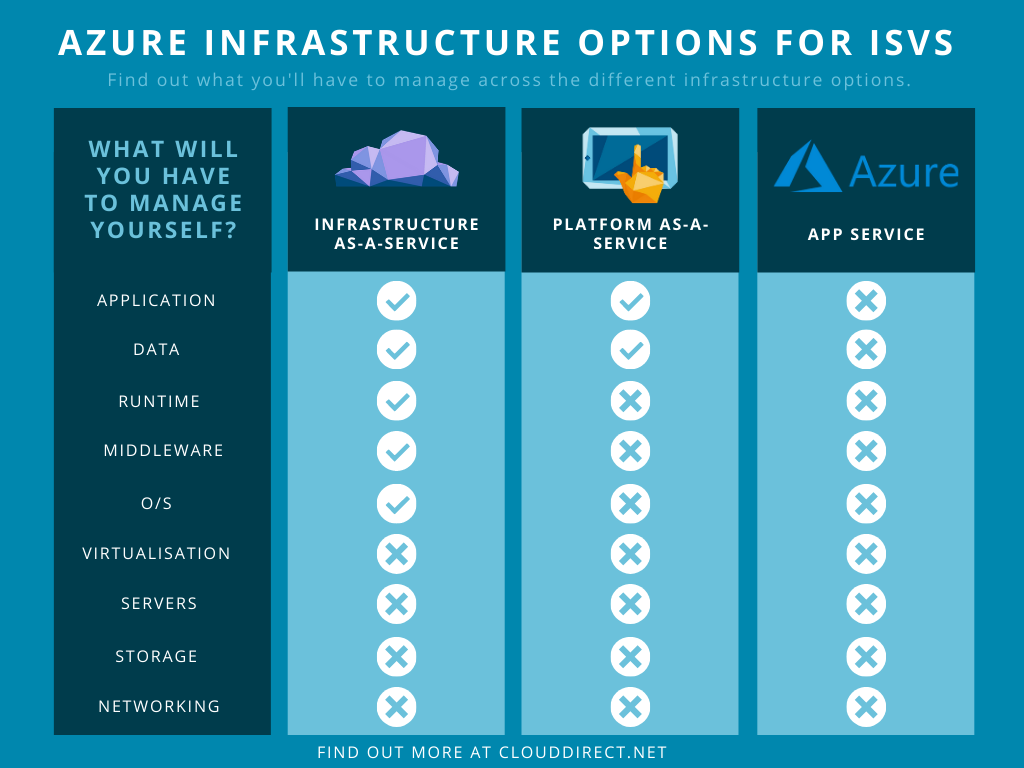Infrastructure options for your application

As an Independent Software Vendor (ISV), your application is at the heart of your business and you’ll understand the importance of leveraging cloud-native technologies for application growth in 2021. Commvault has recently spoken about cloud-native applications and is predicting “IT organisations to make the rearchitecting of their applications and workloads into cloud-native formats one of their top digital transformation priorities for 2021”.
The benefits of moving your application to Azure are endless. In fact, it can completely transform the way your business operates. Reach new by accessing intelligent tools such as Azure Kubernetes Service, Azure DevOps and Azure App Service. The benefits are endless.
Moving your application to Azure can completely transform the way your business operates. You’ll have the ability to reach new markets by accessing intelligent tools such as Azure Kubernetes Service, Azure DevOps and Azure App Service. The benefits are endless.
During this blog post, we’ll be exploring the three infrastructure options for your application in the cloud.
Your options at a glance
When migrating your application or software to Azure you need to decide on whether your application will be delivered as Infrastructure-as-a-Service (IaaS), Platform-as-a-Service (PaaS) or App Service. Here’s an infographic we’ve created that highlights the key differences between these approaches.
Ready to dive into each of these options and what that approach will mean for your business?

Infrastructure-as-a-Service (IaaS)
Infrastructure-as-a-Service is the first step in building new technology that’s delivered over the cloud. This option is usually the quickest for you to get your application up and running in the cloud. IaaS enables you to build and manage data as you grow by only billing you for the storage and server space needed to build hardware or software. Allowing you to scale up and down with ease.
IaaS provides your business with the greatest level of control and power over your software and hardware. However, you’ll still be responsible for making sure everything is secure and up and running to prevent any outages that could impact your business operations.
Platform-as-a-Service (PaaS)
Platform-as-a-Service enables you to provide an online platform that is accessible to developers to start creating software that can be delivered over the internet. PaaS leverages cloud-native technologies but is still very cost-effective. Plus, you’ll only have to manage your application and data, whilst your cloud provider looks after the rest for you.
You’ll be able to free up a lot of your IT team’s time as you’ll be able to create custom applications online without having to deal with any of the data serving, storage or management of the platform – allowing them to focus on building new features into your app. You’ll also gain full control over any software or applications that are being built within the platform.
You’ll be able to create custom applications online without having to deal with any of the data serving, storage or management of the platform. The result? More time for your IT team to focus on building new features into your app. You’ll also gain full control over any software or applications that are being built within the platform.
One of the downfalls of PaaS is that you’ll only be able to control what is built on the platform. Therefore, if there is ever an outage or any issues with the hardware or operating system that the platform is built on, this will affect the software that is being delivered.
Azure App service
Azure App Service is a fully managed platform for building, deploying and scaling your web applications. The platform has built-in infrastructure maintenance, security patching and scaling – allowing you to really focus on transforming your app whilst Microsoft does the heavy lifting. You’ll be able to build, deploy and scale apps quicker than ever. Thanks to the comprehensive security and compliance features in Azure, you’ll be able to do all of this within a trusted managed platform.
Making your application fit for the Azure App Service is often the option that takes the most work, but the long-term cloud-native benefits are incomparable. With your cloud provider managing everything for you, you’ll have the time to continuously optimise your app by leveraging some of the available tools, such as; Azure Monitor, Azure DevOps and Azure Active Directory.
But that’s not all. Microsoft has created a range of pricing and performance options to fit your every need, which offers savings up to 55% when compared to pay as you go.
Want to talk to an expert?
We’re a Microsoft ISV partner and can help seamlessly guide you through your cloud journey. Simply get in touch.


